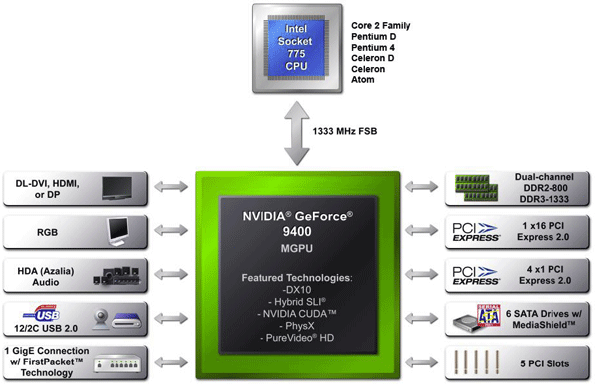NVIDIA Ion Reference PC Platform Deep Dive
Introduction and Specifications

In early January, back from our roadtrip to Vegas with CES show buzz and bewilderment still fresh in our minds, we brought you an interview with Drew Henry, General Manager of NVIDIA's MCP products. Drew gave us a first-hand glimpse at a new small form factor PC platform that NVIDIA was developing based on their recently released GeForce 9400M chipset with integrated graphics. In this new era of HTPCs, netbooks, nettops and all things tiny in general, NVIDIA's Ion reference platform for the Intel Atom processor offers the promise of an ultra low-profile, low power device that quite literally fits in the palm of your hand, and thus could be easily tucked away in various small places in a number of different usage models.
Though the sixty-four thousand dollar question is which of NVIDIA's 3rd party partners will come to market first with an NVIDIA Ion-based product (we're hearing Q2 should be the magic time frame), NVIDIA has given us unfettered access to their tiny, low power, multimedia, all-in-one PC. We've only had it in our test labs for a few days, but we thought we'd share with you our first impressions and a deeper dive on the performance and features of Ion, which will give you a sense of what lies ahead for the platform, as retail products are introduced to market, hopefully in the not too distant future.

|
|
|


As you can see in the block diagram above, with the exception of things like I/O port connectors, power and passive components on the PCB, and physical layer chips for network and video connectivity, Ion is essentially a one chip solution. Supporting Intel's processor families from Core 2 to low power Atom solutions, NVIDIA's Ion MCP offers a multitude of various subsystem functionality. The chipset supports both DDR2 and DDR3 system memory and offers a single x16 PCI Express 2.0 link, as well as 4 x1 links and up to five standard PCI slots. In addition, support for both dual link DVI, HDMI, Display Port and analog RGB video output is built in, along with up to 12 USB 2.0 ports, 6 SATA ports and a single Gigabit Ethernet port.
Finally, of course the integrated graphics core of the GeForce 9400M with its 16 shader engines, offers full DX10 compatibility and full HD video hardware offload, in addition to other features like Hybrid SLI and NVIDIA's CUDA technology. To say that the GeForce 9400M is a Swiss Army knife of a chip may sound a bit cliche' but it's also very true. If you'd like a full refresh on NVIDIA's family of GeForce 9300 and 9400 chipsets, we've covered them in depth here previously. Once you're up to speed on the chipset, let's journey on with a closer look at NVIDIA's new Ion Small Form Factor PC.






